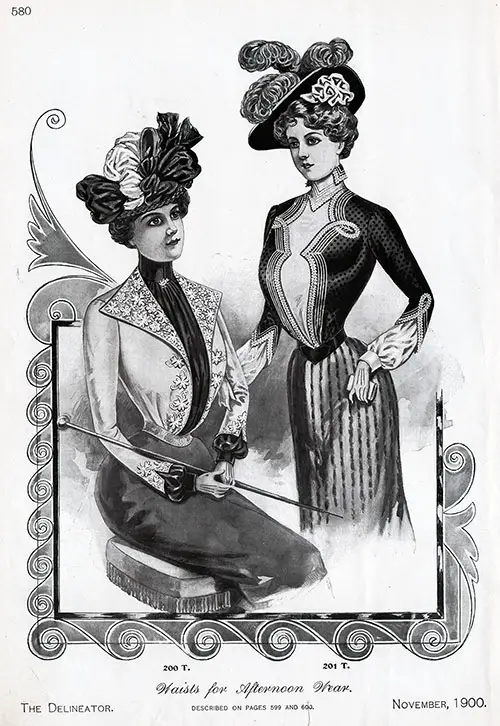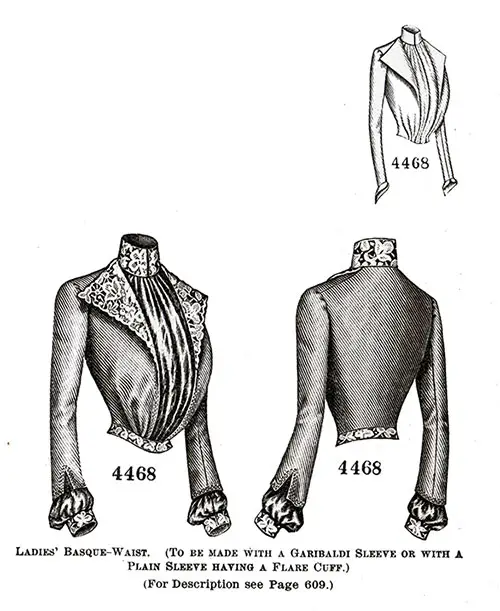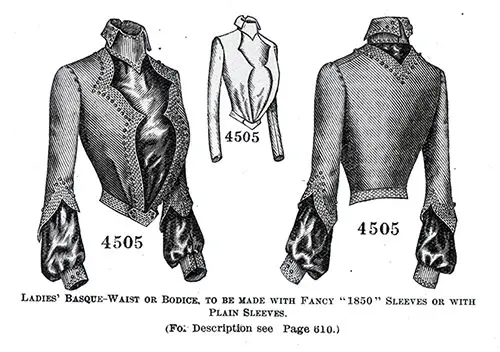Ladies Blouses for Afternoon Wear 200 T & 201 T - 1900

Ladies' Basque Blouse No. 200 T
Garibaldi sleeves are the predominating feature of the blouse here shown in a stylish combination of light and dark silk in harmonizing shades, and effective garniture is contributed by white all-over applique lace and sections cut from the applique.
The drooping outside fronts flare to the shoulders, revealing the full, pouching fronts that are topped by a high stock.
The outside fronts are turned back in large revers, and a shapely belt defines the bottom of the mode, which shows the fashionable dip in front.
The full under-sleeve reaches to the shoulder and is completed by a narrow band; it is revealed in short puff effect below the close-fitting over-sleeve which is notched at the bottom on the upper side. Plain sleeves with flare cuffs may replace the Garibaldi sleeves.
Dressmaker Options
Cloth in light-weight, crêpe de Chine, Louisine, peau de soie and novelty goods in solid and two-toned effects will handsomely develop the blouse, and many effective combinations will result by a wise selection of fabrics and colors. Passementerie, all-over lace and fancy braid may be used to trim.
Pattern Information
The pattern, which is No. 4468 and costs 9d. or 20 cents, is in seven sizes for ladies from thirty to forty-two inches, bust measure, and is shown in a different 4498 development on page 603.

Ladies' Basque-Blouse No. 201 T
This stylish blouse introduces the long effect from shoulder to bust that is now so much sought and will show to excellent advantage a well-developed figure.
The "1850" sleeves are novel features of the design, which shows a pretty arrangement of two varieties of braid, one having a picot edge and the other a plain edge.
Silk in a rich ruby shade spotted with black and plain white were chosen for the blouse in the present instance. The broad, seamless back is cut in V shape at the top to disclose a shallow yoke, and the fronts are fancifully shaped and flare to reveal the vest, which reaches from shoulder to lower edge.
The blouse dips fashionably in front and has graceful fulness drawn well to the center, and the high stock is of unique shaping, extending in a deep point at the front over the vest and being reversed at the sides and back to form turn-over portions.
The lower outline of the over-sleeve harmonizes with the fronts, and the full short under-sleeves are completed with wristbands.
Plain close-fitting sleeves are also included in the pattern, and a fitted belt of plain dark silk, to which is attached a pointed strap at the front, follows the lower edge of the blouse and forms a pretty finish.
Dressmaker Options
Mode cloth combined with white silk overlaid with ecru lace for the vest, yoke and collar and Liberty silk for the under-sleeves will produce a handsome blouse for theatre or house wear; less expensive and more serviceable bodices are developed from cashmere, serge and vailing associated with silk or satin.
Pattern Information
The pattern, which is No. 4505 and cogs 9d. or 20 cents, is in seven sizes for ladies from thirty to forty-two inches, bust measure, and is pictured differently on page 604.
Ladies’ Basque-Blouse No. 4468

No. 4468 Ladies’ Basque-Blouse. (To be made With a Garibaldi Sleeve or with a Plain Sleeve having a Flare Cuff.) (For Description see Page 609.)
Description
This blouse is again illustrated in page 608, and also at figure No. 200 T in this magazine.
Extremely attractive is the mode, which is developed in white cloth associated with pale-blue Liberty satin and all-over lace. The full fronts are turned back at the top to form pointed revers, and at the waist the fulness is collected in gathers.
They flare becomingly and puff out with the full fronts that are gathered at the top and bottom. The stretched back is connected with the fronts by under-arm and shoulder seams, and the closing is made at the center of the front.
The sleeves may be of the plain two-seam variety finished with flare cuffs, or in quaint Garibaldi style, the latter having a two-seam over-sleeve closely adjusted at the top and slightly widened at the bottom where it is slashed, and a full bishop under-sleeve finished with a wristband.
A plain standing collar gives completion to the neck, and the waist, which is made over a Basque-fitted lining, is finished with a narrow-applied belt.
Dressmaker Options
A handsome blouse could be of mauve silk Oxford cord combined with white taffeta and accordion-plaited chiffon. Appliques of Russian lace may be used effectively for garniture.
Fine serge, mohair, lady’s-cloth, English suiting and fabrics of similar nature are appropriate for the blouse, and the vest, collar and under-sleeves will generally be of some pretty contrasting silk. Braid, ribbon, insertion or folds may serve to trim.
Pattern Information
We have pattern No. 4468 in seven sizes for ladies from thirty to forty-two inches, bust measure.
To make the Basque-blouse for a lady of medium size, requires a yard and one-fourth of goods fifty inches wide, with three yards and three-fourths of material twenty inches wide for the collar, full fronts, belt, undersleeves, wristbands, and for facing the revers, and five-eighths of a yard of all-over lace twenty inches wide to cover the collar, revers, belt and wristbands.
Price of pattern, 9d. or 20 cents.
Ladies’ Basque-Blouse or Bodice No. 4505

No. 4505 Ladies’ Basque-Blouse or Bodice, to be made with Fancy “1850” Sleeves or with Plain Sleeves. (For Description see Page 610.)
Description
Illustrations of this blouse are given on page 604, and also at figure No. 201T in this issue.
The association of chocolate-brown cloth and red corded silk in the present development of the blouse produces exceedingly good results, bullet buttons and stitching affording the decorative finish.
The smooth, seamless back is cut in shallow V outline to reveal a plain yoke, and the uniquely shaped fronts separate over a vest that is fastened at the left side and gathered at the waist, where it puffs out becomingly.
The “1850” sleeve has a plain one-seam upper portion that terminates a little below the elbow in fanciful outline and a two-seam lining on which is mounted a full one-seam under-portion that extends to the elbow and at the bottom, where it droops prettily, is completed with a wristband.
The sleeve is left open at the seam for a short distance, and the wristband closes invisibly. If a less elaborate effect be desired, a plain two-seam sleeve may be used.
An odd collar that is shaped to form deep turn-over portions and extends in a point at the center of the front gives neck completion.
A narrow belt, having its ends secured under a shaped strap, follows the lower edge of the waist, which shows the fashionable Marie Antoinette dip and the long effect from bust to shoulder that are such striking features of up-to-date blouses. A fitted lining gives support to the waist.
Dressmaker Options
Zinc lady’s-cloth associated with embroidered taffeta with appliqué lace for decoration would reproduce the mode attractively.
Voile, tunic cloth, cashmere, vailing, Henrietta, etc., in combination with some contrasting fabric, are also appropriate for the design, and hands of Oriental embroidery, passementerie, velvet ribbon, etc., could be used for garniture.
Striped mauve and white Liberty silk will unite harmoniously with all over ecru appliqué lace for the mode, and velvet ribbon may be used for the belt or a row of tinsel braid crossed at the front may be chosen instead.
Pattern Information
We have pattern No. 4505 in seven sizes for ladies from thirty to forty-two inches, bust measure.
To make the Basque-blouse for a lady of medium size, will require a yard and one-fourth of material fifty inches wide, with a yard and one-fourth of goods twenty inches wide for the vest, undersleeves and back-yoke.
Price of pattern, 9d. or 20 cents.
“Descriptions of Figures in Colors, Tints, Etc., Shown on First Page of Cover and Pages 571 to 591 Inclusive,” in The Delineator: An Illustrated Magazine of Literature and Fashion, Paris-London-New York-Toronto: The Butterick Publishing Co. Ltd., Vol. LXI, No. 5, November 1900, p. 580, 599-600, 603-604, 609-611.
Editor's Note: Some terminology used in the description of women's clothing during the 1800s and early 1900s has been changed to reflect more modern terms. For example, a women's "Toilette" -- a form of costume or outfit has an entirely different common meaning in the 21st century. Typical terms applied to "toilette" include outfit, ensemble, or costume, depending on context.
Vintage Blouse Fashions
GG Archives
Vintage Blouse Fashions
- Ladies Attractive Bodices 182&183 T - 1900
- Ladies Blouses Foe Afternoon Wear 200&201 T - 1900
- Ladies House Jacket 350 L - 1890
- Ladies Stylish Blouses 202&203 T - 1900
- Ladies Blouses and Sleeves 7430 7395 7411 - 1904
- Ladies’ Shirt-Waists and Sleeves 7381 7380 7429 - 1904
- Ladies Blouses, Shirt-Waists and Sleeves 7402 7416 7421 - 1904
- Blouses of French Elaboration - 1922
- Trend in Luxurious and Practical Blouses 1922
Vintage Fashion Topics
Updates and Social Media
- Visit our GG Archives Vintage Fashions Facebook Page for the Latest News About the Activities of the Archives.
